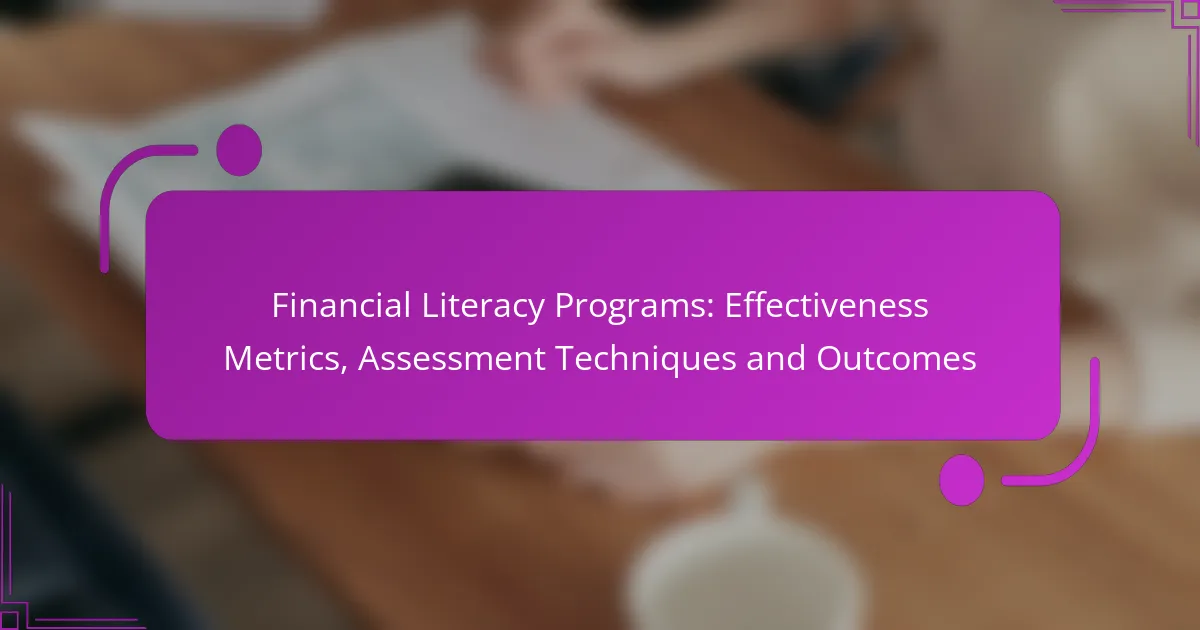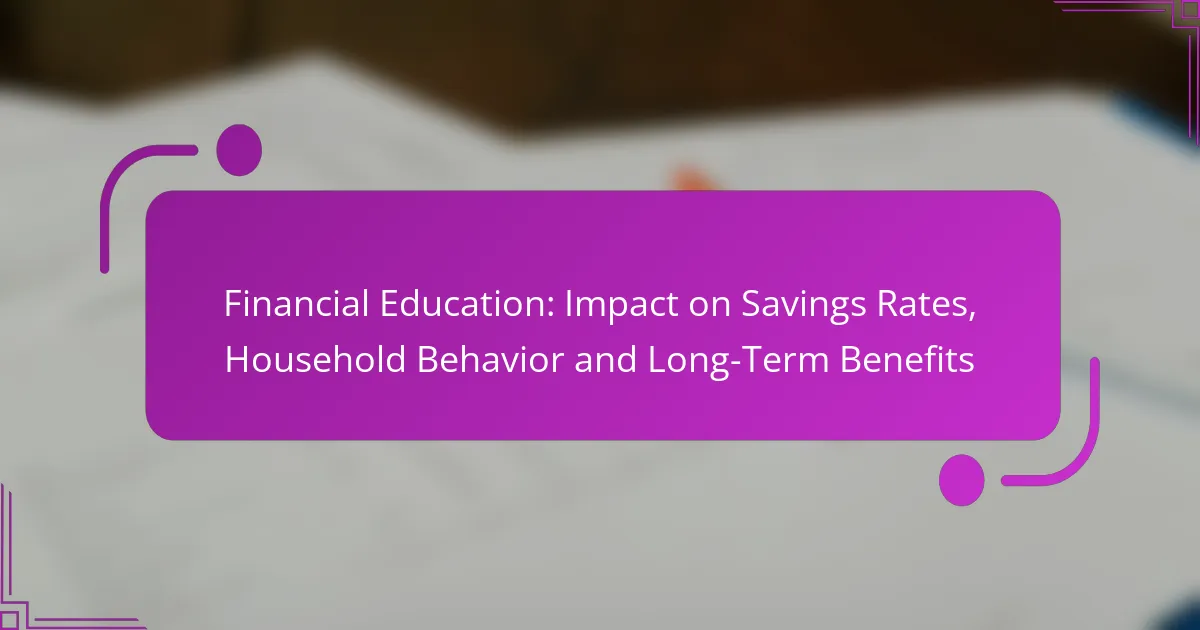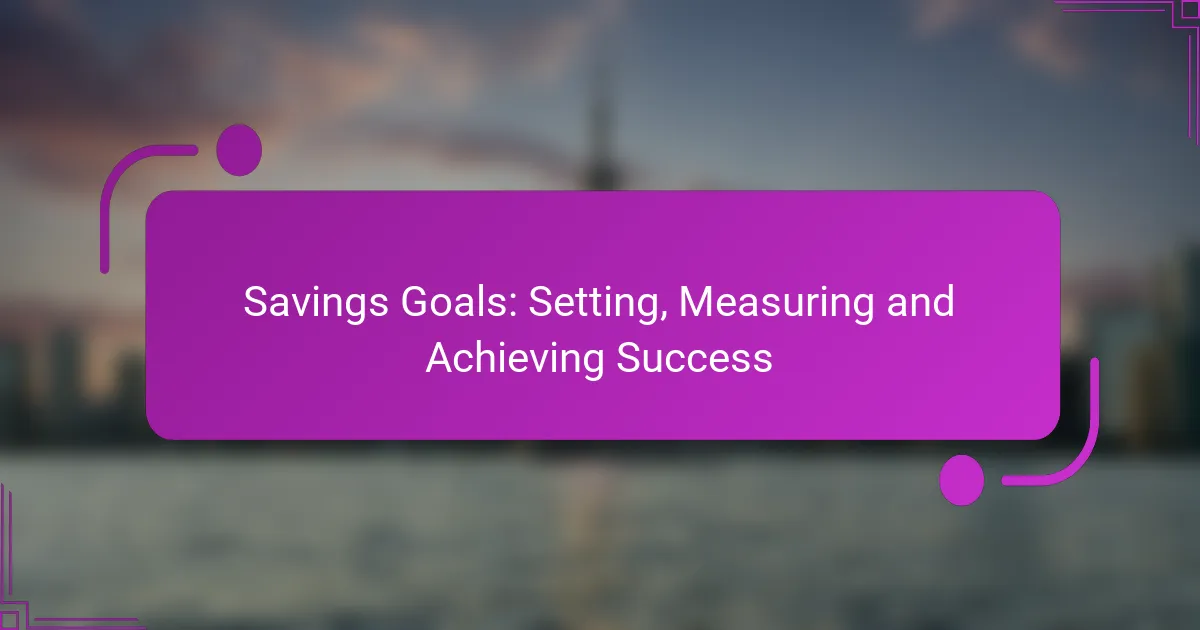Financial literacy programs play a crucial role in empowering individuals to make informed financial decisions, tailored to diverse demographics through various delivery methods. To gauge their effectiveness, these programs employ a range of assessment techniques, including surveys and behavioral tracking, to evaluate participants’ knowledge and financial well-being before and after completion. By analyzing these metrics, stakeholders can better understand the impact of financial literacy initiatives on individuals’ financial behaviors and outcomes.
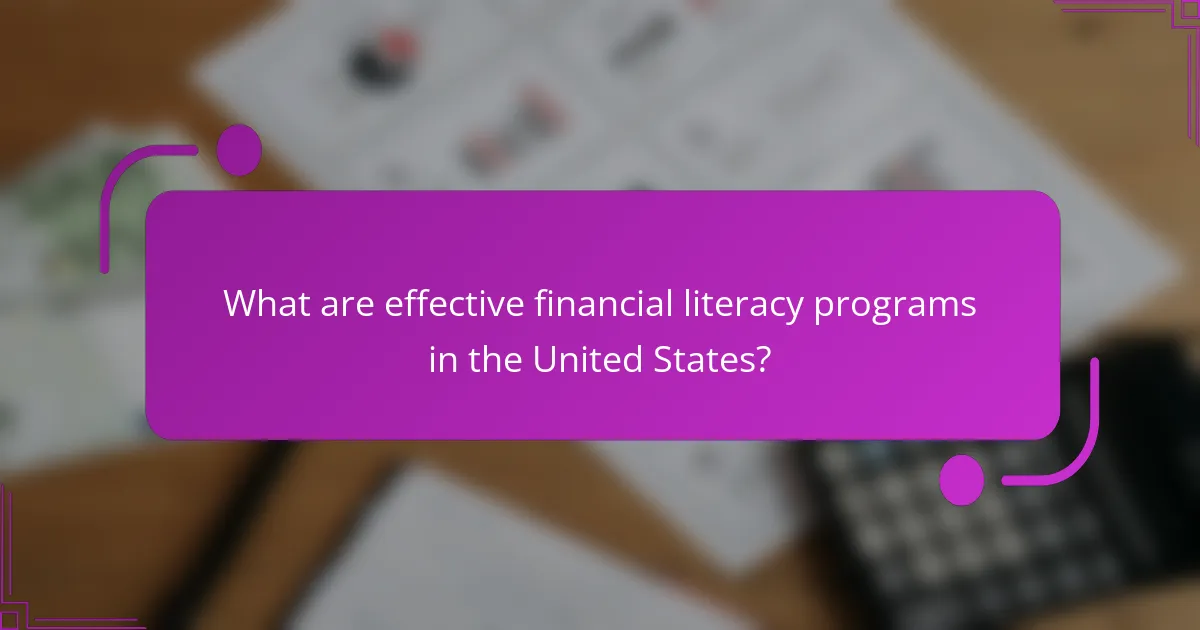
What are effective financial literacy programs in the United States?
Effective financial literacy programs in the United States equip individuals with the knowledge and skills to make informed financial decisions. These programs vary in focus, target audience, and delivery methods, ensuring they meet diverse needs across different demographics.
Programs by National Endowment for Financial Education
The National Endowment for Financial Education (NEFE) offers a range of programs designed to enhance financial literacy among various age groups. Their initiatives include resources for high school students, college students, and adults, focusing on budgeting, saving, and investing.
One notable program is the NEFE High School Financial Planning Program, which provides educators with free materials to teach students essential financial concepts. This program emphasizes practical skills, such as creating a budget and understanding credit, which are crucial for young adults entering the workforce.
Jump$tart Coalition for Personal Financial Literacy initiatives
The Jump$tart Coalition promotes financial literacy through partnerships with various organizations and educational institutions. Their initiatives focus on developing standards for personal finance education and providing resources to educators and students.
One key aspect of Jump$tart’s work is the National Standards in K-12 Personal Finance Education, which outlines essential topics that should be covered in financial education curricula. This framework helps ensure that students receive a comprehensive understanding of financial concepts, preparing them for real-world financial challenges.
Financial Literacy for Youth by the Consumer Financial Protection Bureau
The Consumer Financial Protection Bureau (CFPB) offers the Financial Literacy for Youth program, aimed at empowering young people with the skills needed to manage their finances effectively. This program includes interactive tools and resources that engage youth in learning about money management.
CFPB’s resources cover topics such as saving, spending, and understanding credit. By incorporating real-life scenarios and decision-making exercises, the program helps youth apply financial concepts to their everyday lives, fostering a sense of responsibility and confidence in managing their finances.

How do you measure the effectiveness of financial literacy programs?
Measuring the effectiveness of financial literacy programs involves assessing participants’ knowledge, behaviors, and overall financial well-being before and after the program. Key metrics include surveys, behavioral tracking, and knowledge tests to evaluate changes and improvements.
Pre- and post-assessment surveys
Pre- and post-assessment surveys are essential tools for measuring the effectiveness of financial literacy programs. These surveys typically gauge participants’ financial knowledge, attitudes, and behaviors before they begin the program and again after completion.
To maximize the effectiveness of these surveys, ensure they cover key topics such as budgeting, saving, and investing. Consider using a mix of multiple-choice questions and open-ended responses to capture a range of insights.
Behavioral change tracking
Behavioral change tracking involves monitoring participants’ financial actions over time to assess the impact of the program. This can include tracking changes in spending habits, savings rates, or debt management practices.
Utilizing tools like mobile apps or financial tracking software can help participants record their behaviors and provide data for analysis. Regular check-ins can also encourage accountability and reinforce positive financial habits.
Financial knowledge tests
Financial knowledge tests are structured assessments designed to evaluate participants’ understanding of financial concepts after completing the program. These tests can include questions on topics such as interest rates, investment strategies, and retirement planning.
To ensure the tests are effective, align them with the program’s learning objectives and consider using a mix of formats, such as true/false questions and case studies. Providing feedback on test results can help participants identify areas for further improvement.
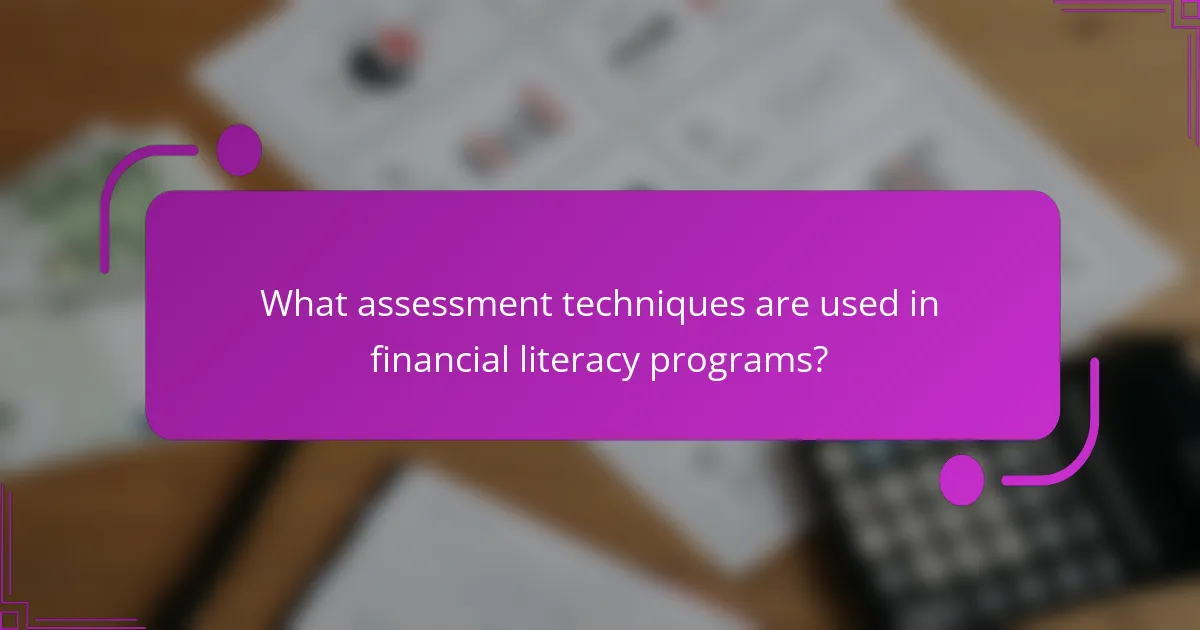
What assessment techniques are used in financial literacy programs?
Financial literacy programs utilize various assessment techniques to measure effectiveness and participant understanding. Common methods include standardized testing, qualitative feedback, and longitudinal studies that track changes in financial behavior over time.
Standardized testing methods
Standardized testing methods provide a quantifiable measure of participants’ financial knowledge before and after program completion. These tests often cover key concepts such as budgeting, saving, investing, and understanding credit. They can be administered in a controlled environment to ensure consistency.
Common formats include multiple-choice questions and scenario-based assessments. Programs may use established tests like the Jump$tart Coalition’s financial literacy test to benchmark results against national averages.
Qualitative feedback from participants
Qualitative feedback from participants offers insights into their personal experiences and perceived value of the financial literacy program. This feedback can be collected through surveys, interviews, or focus groups, allowing participants to express their thoughts on the curriculum and teaching methods.
Analyzing qualitative data helps identify strengths and weaknesses in the program. For instance, if many participants report feeling more confident in managing their finances, this can indicate successful outcomes, while consistent complaints about unclear materials may signal areas needing improvement.
Longitudinal studies on financial behavior
Longitudinal studies track participants over an extended period to assess changes in financial behavior and decision-making. These studies can reveal the long-term impact of financial literacy programs on savings rates, debt management, and investment choices.
For effective longitudinal research, programs should establish baseline financial behaviors and regularly collect data at intervals, such as annually. This approach helps determine whether the skills learned are applied in real-life situations and how they influence participants’ financial well-being over time.
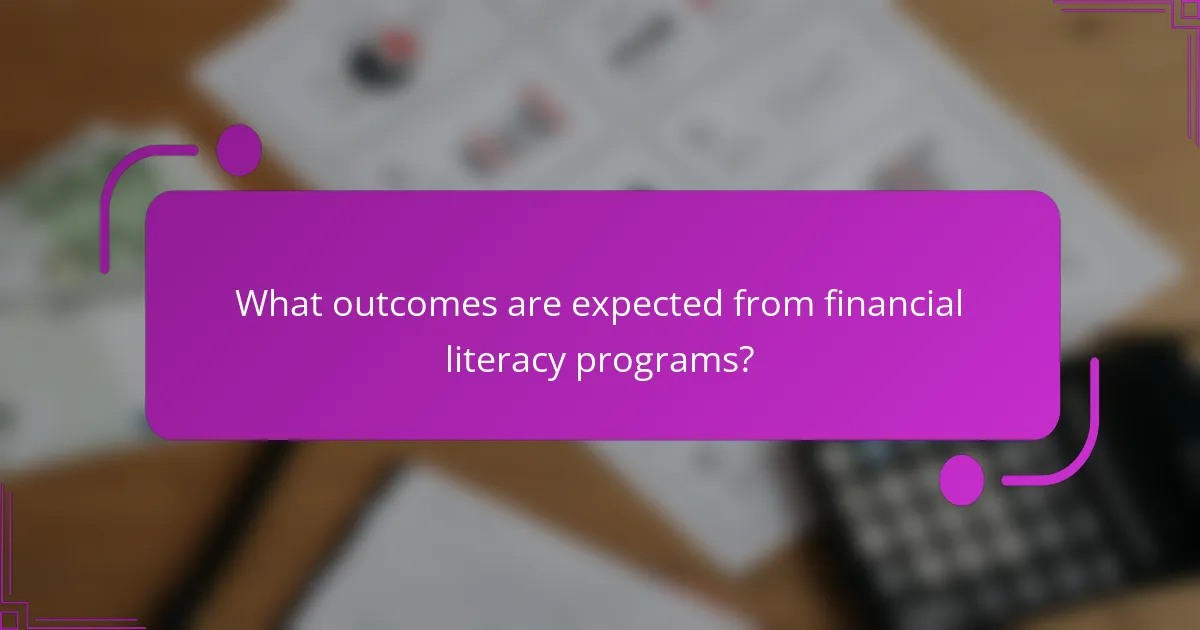
What outcomes are expected from financial literacy programs?
Financial literacy programs aim to equip individuals with the knowledge and skills necessary to manage their finances effectively. Expected outcomes include improved budgeting skills, increased savings rates, and enhanced credit scores, all of which contribute to better financial stability.
Improved budgeting skills
Improved budgeting skills are a primary outcome of financial literacy programs. Participants learn to track income and expenses, set financial goals, and create realistic budgets that reflect their priorities. For example, a well-structured budget can help individuals allocate funds for necessities while also allowing for discretionary spending.
To enhance budgeting skills, individuals should regularly review their budgets and adjust them as needed. Common pitfalls include underestimating expenses or failing to account for irregular costs, such as car maintenance or medical bills. Using budgeting apps can simplify this process and provide real-time insights.
Increased savings rates
Increased savings rates are another key outcome of financial literacy programs. By understanding the importance of saving, individuals are more likely to set aside a portion of their income for emergencies, retirement, or specific goals. A common recommendation is to aim for saving at least 20% of monthly income, though this can vary based on personal circumstances.
To boost savings rates, participants should consider automating their savings through direct deposits into savings accounts. This strategy reduces the temptation to spend excess funds. Additionally, exploring high-yield savings accounts can maximize interest earnings, further encouraging the habit of saving.
Enhanced credit scores
Enhanced credit scores are a significant benefit of financial literacy programs. Participants learn how credit scores are calculated and the factors that influence them, such as payment history, credit utilization, and length of credit history. A higher credit score can lead to better loan terms and lower interest rates, saving individuals money over time.
To improve credit scores, individuals should consistently pay bills on time and keep credit card balances low. Regularly checking credit reports for errors and disputing inaccuracies can also help maintain a healthy credit profile. Understanding the impact of new credit inquiries is crucial, as too many applications in a short period can negatively affect scores.

What are the prerequisites for implementing financial literacy programs?
Implementing financial literacy programs requires a clear understanding of the target audience and secure funding sources. These prerequisites ensure that the programs are tailored effectively and can be sustained over time.
Understanding target audience demographics
Identifying the demographics of the target audience is crucial for tailoring financial literacy programs. Factors such as age, income level, education, and cultural background can significantly influence the content and delivery method of the program.
For example, programs aimed at young adults may focus on student loans and budgeting, while those for older adults might emphasize retirement planning and investment strategies. Conducting surveys or focus groups can provide valuable insights into the specific needs and preferences of the audience.
Identifying funding sources
Securing funding is essential for the successful implementation of financial literacy programs. Potential funding sources include government grants, private donations, corporate sponsorships, and partnerships with educational institutions.
It is advisable to research local and national grants that support financial education initiatives. Additionally, forming partnerships with local businesses can provide both financial support and resources, such as venues for workshops or promotional materials.
